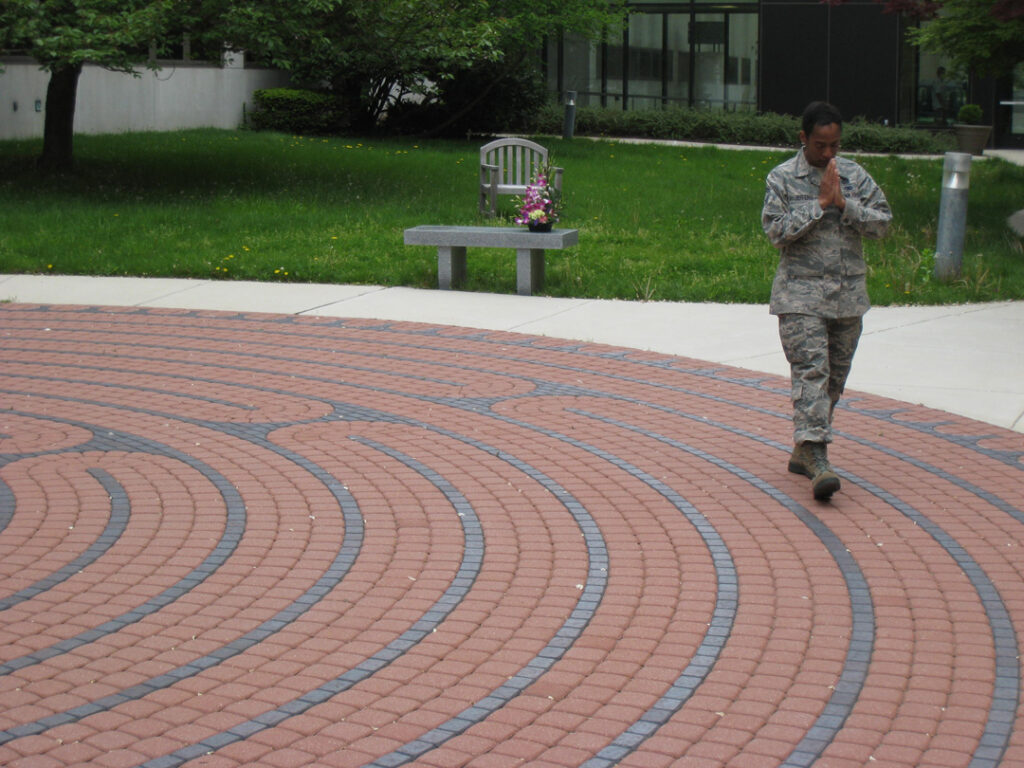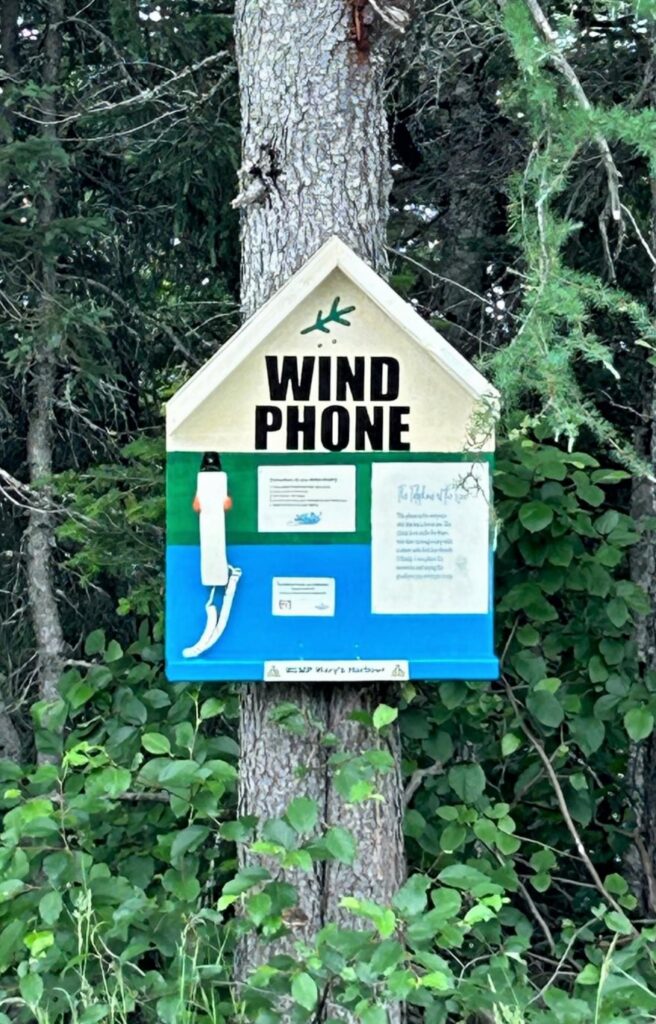
Features
Opinion
From isolation to restoration: Wellness spaces as effective coping strategies for first responders
April 3, 2025 By Andrea Perchotte
 Photo credit: Cintia Cabib
Photo credit: Cintia Cabib Labyrinth designer and builder Debi Kermeen recalls a moment at the Walter Reed National Military Medical Center (WRNMMC) in Bethesda, Maryland, one of the largest military medical facilities in the world. As she and her husband, Marty Kermeen, were completing the construction of one of the two labyrinths there, a man—whom she later learned had deep invisible wounds—asked about it.
Kermeen invited him to carry a brick to the centre of the labyrinth, symbolizing a burden or even an open palm, explaining that there was no wrong way to do it. “When you reach the centre,” she advised, “place it there with love and compassion, or possibly even anger. When you are ready, you can retrace your steps back into your life.” At the end of his walk, Kermeen recounts, “he shared that it was beneficial for him; no expectations were placed upon him, and the labyrinth met him where he was. He felt lighter and mentioned he would return as he felt the need.”
Like the man in the labyrinth, police officers often bear heavy burdens, isolating themselves to manage the impact of challenging calls, which can escalate into personal crises. A global study1 of police personnel highlights the prevalence of depression, anxiety, PTSD, suicidal thoughts, and alcohol misuse, with researchers emphasizing the need to tackle these issues. Free, health-promoting resources such as labyrinths, wind phones, and libraries are emerging as valuable aids for recovery and post-traumatic growth.
Healing pathways
Located in such settings as parks, churches and retreats, “A labyrinth is a safe and beautiful space to meditate, relax and reflect,” explained Cintia Cabib, filmmaker of “Labyrinth Journeys”. In the documentary, Cabib shares stories of several individuals who use labyrinths, including those at the WRNMMC, “as a tool for healing, rehabilitation, meditation, stress reduction, spiritual awareness and playful exploration.” Featured labyrinth walkers include an Iraq war veteran who sustained traumatic brain injuries and a military servicewoman who is a breast cancer survivor.
These swirling pathways date back over 4,000 years, with one of the earliest examples found in Greece. By the 13th century, they were integrated into church floors, like the famous one in France’s Chartres Cathedral. Colonizers spread labyrinths worldwide by the 19th century. Today, there are over 300 public labyrinths in Canada, including the Carol Shields Memorial Labyrinth in Winnipeg, Man., and Mary’s Labyrinth at the Crossing at Grasslands in Val Marie, Sask. The Labyrinth at Fairview Park in St. Catharines, Ont., is supported in part by the Valhalla Project Niagara, a non-profit charity founded by first responders for first responders and veterans suffering from PTSD.
Health-promoting resources such as labyrinths, wind phones, and libraries are emerging as valuable aids for recovery and post-traumatic growth.
Research2,3,4 points to labyrinths as beneficial to one’s physical, mental and emotional health. Unlike a maze, which is designed to confound, a labyrinth has a singular path to the centre and prompts soulful contemplation. Kermeen says a labyrinth “is not a cure-all, but it offers a beginning, helping [people] get in touch with the difficulties they are facing and giving them the courage to face them.”
Cabib encourages labyrinth walkers to disconnect from phones, quiet the mind, relax, walk at one’s own pace and stay in the present moment. With World Labyrinth Day on May 3rd, it’s the perfect opportunity for officers to focus on self-care by participating individually or with family, friends and colleagues.
Therapeutic phones
While tools from ancient times help us reconnect with ourselves, one modern creation is proving equally therapeutic. In 2010, Itaru Sasaki of Ōtsuchi, Japan, was mourning the loss of his cousin to cancer and set up a disconnected rotary phone in his garden, calling it kaze no denwa, the phone of the wind. “The phone won’t carry my voice, so I let the wind do it,” explains Sasaki in the documentary “The Phone of the Wind: Whispers to Lost Families”.
After the 2011 earthquake and tsunami claimed the lives of nearly 20,000 people in a nearby city, Sasaki opened up his phone booth to mourners. Since then, thousands from around the world have made the pilgrimage. Nearly 350 wind phones have been established in 17 countries, often in natural settings, with Canada being home to approximately 70 of them.
Concordia University communications scholar Laura Boyce concludes in her research5 that mourners are drawn to wind phones because they offer “an interactive sensorial encounter that is not necessarily available through traditional material objects associated with mourning, such as gravestones, statues, plaques and other inanimate objects.”
Exposure to death and trauma are inevitable for police officers, and healthy grief processing is essential. However, there are times when externalizing these feelings can be awkward. This is where wind phones can be healing.

Photo credit: Tom Roach
Corporal Tom Roach, Detachment Commander of Newfoundland and Labrador’s RCMP Mary’s Harbour Detachment, describes the phones as a “coping tool that give[s] me a level of comfort.” After seeing a YouTube video about them, Roach thought to himself, “We deal with a lot of mental health complaints in the community – these people have no one to talk to. So, maybe I can apply this to our situation.”
Alongside Mental Health and Addictions Counsellor Grace Julian of Newfoundland Health Services, Labrador Grenfell Zone, Roach approached local leaders who supported the idea. After the overwhelmingly positive response in the community to the first one he built, Roach set up wind phones in three nearby communities. The 18-year veteran reveals, “The installation of four wind phones caused more conversation about mental health issues than I have seen in years.” Roach adds, “For first responders, the whole mental health thing wasn’t brought into the light until recently. No one ever wanted to do that – you just dealt with it on your own.”
Roach acknowledges his wind phones won’t solve the mental health crisis. “If my four wind phones help lessen the stigma … and somehow spurs four other people to make four more wind phones, that’s 16 wind phones!! Well, now we’re getting somewhere. The more we do about mental health, the better we are.”
Rejuvenating havens
Canadian municipalities reflect this sentiment, transforming book repositories into versatile architectural icons that promote well-being. Providing a safe, quiet, welcoming space, libraries allow police personnel to unwind. A growing trend involves integrating natural elements into library design, enhancing a calming atmosphere. Calgary’s Central Library embraces visitors with warm wood finishes, centred around an impressive 85-foot atrium. Similarly, Vancouver Public Library’s Central Branch, a postmodern homage to the Roman Coliseum, features a tranquil rooftop garden, while Halifax Central Library, a light-filled glass masterpiece, boasts a patio with views of the city.
Across Canada, cities offer an array of free library programs ranging from computer classes and writers’ groups to art exhibitions and cultural activities. These enable officers to engage in skill building, creativity and social connection. Last year, Markham Public Library hosted 520 wellness programs through community partners, according to Diane Macklin, Director of Community Engagement. They are also addressing mental health by providing individual counselling through a local organization, curated reading lists, displays and social media posts. “We hope that our efforts normalize the conversation around mental health and create an environment in which the community is comfortable in seeking information and help,” says Macklin. “A healthy community is more resilient, more engaged and more supportive of each other.”
Likewise, the Calgary Public Library offers a free Wellness Desk where visitors can obtain immediate support or referrals to crisis counsellors. According to Kristen Duke, Service Design Lead, this initiative “has been well utilized and well received by our community,” and the vast majority of visitors “reported getting the help they needed and having a clear next step to support their needs.”
Is it time to start a new chapter in your life by recharging with health-affirming tools like labyrinths, wind phones and libraries? Now that’s a page-turner.
References
- Syed, S., et al. (2020). “Global prevalence and risk factors for mental health problems in police personnel: a systematic review and meta-analysis.” Occupational and environmental medicine, 77(11), 737–747. https://doi.org/10.1136/oemed-2020-106498.
- Behman, P. J., et al. (2018). “Short-term autonomic nervous system and experiential responses during a labyrinth walk.” Cogent Psychology, 5(1). https://doi.org/10.1080/23311908.2018.1495036.
- Weaver, M. S., et al. (2019). “Centering care: The role of labyrinths for fostering reflection in pediatric palliative and critical care settings.” Journal of Pain and Symptom Management, 58(1), 167-170. https://doi.org/10.1016/j.jpainsymman.2018.09.010.
- Butcher, H. K. (2023). “A unitary caring theory perspective of labyrinth walking research.” Nursing Science Quarterly, 36(2), 116–125. https://doi.org/10.1177/08943184221150258.
- Boyce, L. (2022). “‘If you’re out there, please listen to me…’: Voices of mourning through the Wind Phone (Kaze no Denwa).” Refract: An Open Access Visual Studies Journal, 5. http://dx.doi.org/10.5070/R75159689. Retrieved from https://escholarship.org/uc/item/7s96s6kb.
Author’s note: If you are struggling with a mental health issue, reach out to your organization’s support program, call 9-1-1, or call or text the Suicide Crisis Hotline: 9-8-8.
Andrea Perchotte is a Vancouver-based wellness spaces consultant, speaker and writer. Connect with her at andrea@exploringwellness.ca.
Print this page